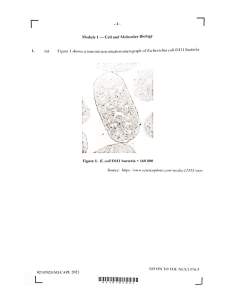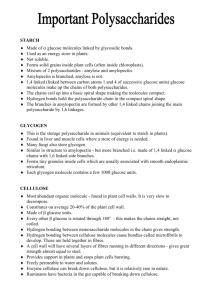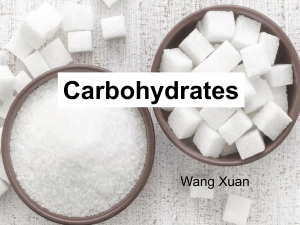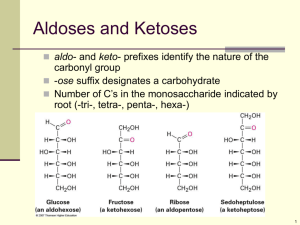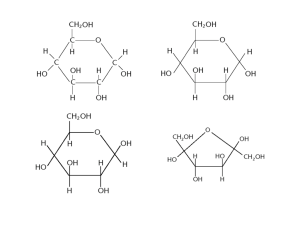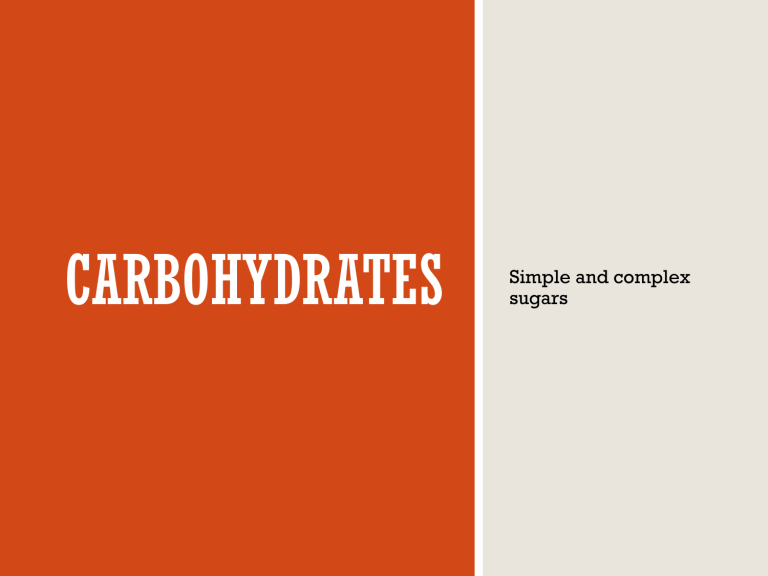
CARBOHYDRATES Simple and complex sugars ▪ 1.3. Explain the relationship between the structure and function of glucose ▪ Exact molecular ring structure in full ▪ Distinguish between the structures of alpha and beta glucose 2 ▪ A group of organic compounds whose molecules contain atoms of carbon, hydrogen and oxygen only. ▪ Are hydrates of carbon ▪ The ratio of hydrogen atoms to oxygen atoms is always 2:1 ▪ General formula: 𝐶𝑥 𝐻2 𝑂 𝑦 ▪ They are the most abundant organic molecules. ▪ They are the primary energy storage molecules in most organisms. ▪ Energy is released when the covalent bonds are broken. 3 ▪ Monosaccharides – These contain a single sugar molecule (e.g. glucose & fructose) ▪ Disaccharides – these are made up of two sugar molecules linked by a covalent bond. (e.g. sucrose) ▪ Polysaccharides – large molecules made of many sugar units sugar units linked together. 4 5 ▪ Are the simplest types of carbohydrates ▪ Their general formula is (CH2O)n, ▪ n can be any number from 3 – 7. ▪ Have the same number of carbon atoms as oxygen atoms in the molecule ▪ They all contain a ketone or aldehyde functional group. 6 ▪ They are named according to number of carbons in their structure or their functional group ▪ They are soluble ▪ Dissolve in water to give sweet tasting solutions ▪ Once in solution, they readily reduce other chemicals and are called reducing sugars. 7 According to number of carbons: According to functional group. ▪ Triose – 3 carbons ▪ Aldose – has an aldehyde ▪ Tetrose – 4 carbons ▪ Pentose – 5 carbons ▪ Hexose – 6 carbons functional group (-CHO) ▪ Ketose – has a ketone functional group ( -C=O) ▪ Heptose – 7 carbons 8 Glyceraldehyde Dihydroxyacetone Triose Triose Aldose Ketose The structural formulae are given what are the molecular formulae for these trioses? What is the relationship between these two sugars? 9 Aldose Ketose Hexose Hexose Glucose Fructose 10 11 ▪ An oxidation-reduction (redox) reaction is a type of chemical reaction that involves a transfer of electrons between two species ▪ When a substance such as a sugar, reduces another chemical, it takes oxygen, or electrons, from that chemical or donates hydrogen to it. ▪ In doing this, the substance or sugar becomes oxidized. ▪ Oxidation Is Loss of electrons ▪ Reduction Is Gain of electrons ▪OIL RIG 12 ▪ When in solution they have a free aldehyde or ketone group. ▪ They are able to supply electrons and therefore act as reducing agents. ▪ They are identified by their ability to reduce Cu2+ to Cu+, this is seen as a change from blue to brick red. 13 Both these forms of glucose are able to donate electrons and act as a reducing agent. 14 ▪ Hexoses are the main source of energy for a living organism ▪ Glucose, fructose and galactose ▪ Compounds with the same molecular formula but a different arrangement of atoms are called isomers. ▪ Same molecular formula, different structural formulae 15 ▪ The most common monosaccharide. ▪ Molecular formula: C6H12O6 ▪ It is highly soluble. ▪ It is the primary respiratory substrate of cells. ▪ It is the only respiratory substrate of brain cells. ▪ It can be used to synthesise other biomolecules. 16 ▪ Isomers are molecules with the same chemical formula but different structural formulae ▪ Glucose can exist in 2 ring forms. These are referred to as the alpha (α) and beta (β) forms ▪ α glucose: the hydroxyl group on carbon 1 projects below the ring ▪ β glucose: the hydroxyl group on carbon 1 projects above the ring 17 https://www.google.com/url?sa=i&rct=j&q=&esrc=s&source=images&cd=&cad=rja&uact=8&ved=2ahUKEwjZttKVi cXdAhVphAKHWtfDi0QjRx6BAgBEAU&url=https%3A%2F%2Fthebiochemgazette.wordpress.com%2Ftag%2Fpolysaccharide %2F&psig=AOvVaw2OQcG1aGTdQbIOYrQiNlZT&ust=1537374490146747 18 http://bio1151.nicerweb.com/Locked/media/ch05/glucose.html 19 20 ▪ Molecular formula: C6H12O6 ▪ Sweetest of all the naturally occurring sugars ▪ Found in fruits vegetables and honey 21 https://slideplayer.com/slide/4450347/14/images/10/Haworth+Structure+of+Fructose.jpg 22 ▪ Molecular formula: C6H12O6 ▪ Found in dairy products, avocad os, sugar beets 23 24 25 26 ▪ 1.2. Discuss that macromolecules are polymers made up of their individual monomers and formation and breakage of bonds ▪ 1.4.Explain the relationship between the structure and function of sucrose ▪ Exact molecular ring structure in full 27 ▪ Condensation ▪ Two smaller molecules join together to form a larger molecule. One molecule of water is released: AOH + BH AB + H2O ▪ Hydrolysis ▪ A large molecule reacts with water and splits into two smaller ones: AB + H2O AOH + BH 28 ▪ Are formed when 2 monosaccharides react together by means of a condensation reaction Condensation C6H12O6 + C6H12O6 C12H22O11 + H2O Hydrolysis ▪ The covalent bond produced is known as a glycosidic linkage. ▪ Glycosidic linkages are found in disaccharides and polysaccharides. 29 1 – 4 glycosidic 1 -6 glycosidic ▪ Formed between C1 and ▪ Formed between C1 and ▪ Is found in disaccharides ▪ Is found in molecules that ▪ Examples: Maltose, ▪ Example: glycogen and C4 of successive monomer units. and un-branched chains. amylose a constituent of starch. C6 of successive monomer units. have branched chains amylopectin. 30 http://web.sls.hw.ac.uk/teaching/Derek_J/A1 3MM1web/Lectures/files/polysaccharides/index.ht http://namrataheda.blogspot.com/2013/04/bi ml omolecules-of-cell-carbohydrates31 part_16.html 32 33 https://socratic.org/questions/can-anyone-explain-to-me-how-to-identifyepimers-and-anomers-in-carbohydrates-su 34 35 https://illuminolist.wordpress.com/tag/d-l-designation/ The formation of maltose http://oregonstate.edu/instruction/bi3 14/summer09/chemone.html The formation of sucrose http://cnx.org/contents/185cbf87c72e-48f5-b51ef14f21b5eabd@9.45:11 36 37 38 39 ▪ The most common non-reducing sugar ▪ It is highly soluble ▪ It is chemically inert. ▪ It is the form in which plants transport their food. ▪ Formed when alpha-glucose condenses with fructose ▪ Molecular formula: C12H22O11 ▪ Harvested from the stems of sugar cane (Saccharum officinarum) 40 ▪ Draw on board 41 42 1 43 44 45 ▪ 1.5. Discuss how the molecular structure of starch, glycogen and cellulose relate to their functions in living organisms ▪ Molecular structure ▪ Types of bonds ▪ Chain and ring structure where appropriate ▪ 3D nature ▪ Hydrolysis and condensation reactions ▪ Relate structure to properties 46 ▪ A polymer of α-glucose ▪ It is the primary storage polysaccharide in plants ▪ Is not found in animals ▪ Has compact & insoluble molecules therefore ideal for in which to store glucose molecules and these can be reformed by hydrolysis when needed ▪ Made up of two different forms ▪ Amylose (20 – 30%) ▪ Amylopectin (70 – 80%) ▪ Starch can be found in tubers, leaves and the endosperm of seeds(wheat) 47 ▪ Has compact & insoluble molecules therefore ideal for in which to store glucose molecules and these can be reformed by hydrolysis later, when needed. 48 ▪ Linear, un-branched chain that forms a helix. ▪ One molecule may contain about 1000 α-glucose residues. ▪ What bonds exist between the monomer units? ▪ The bonds cause the chains to coil helically ▪ Due to the long un-branched chains amylose can be compacted making it a good storage molecule 49 50 https://www.smartkitchen.com/resources/amylose ▪ Many alpha-glucose molecules condense together forming 1,4 glycosidic bonds, producing long unbranched chains. ▪ These chains take a helical (coiled) configuration as each monomer has a bulky side group which has to be accommodated. 51 52 53 54 ▪ Contain 1000 – 6000 or more α-glucose residues. ▪ Short chains of 8 – 12 units branch of the main chain every 24 – 30 monomers. ▪ At every branch point there is an α- 1,6 glycosidic bond. ▪ Amylopectin is insoluble in water due to the cross-links between adjacent hydroxyl groups. 55 56 https://www.smartkitchen.com/resources/amylopectin http://www1.lsbu.ac.uk/water/starch.html 57 58 ▪ The common storage polysaccharide in prokaryotes, fungi and animals. ▪ The animal equivalent of starch ▪ Consist of a main chain with branches every 8 – 12 α-glucose residues ▪ Glycogen branches (with α-1,6 glycosidic linkages) more extensively than starch ▪ The branching makes glycogen very dense which makes it easy to store in liver and muscle cells ▪ Energy reserve 59 https://glossary.periodni.com/glossary.php?en=glycogen 60 http://physicalrules.com/2017/05/glycogen-storage-depletion-and-repletion-week-1/ 61 62 ▪ The parallel chains of β-glucose interact with each other via hydrogen bonding ▪ The OH groups projecting above and below the molecule hydrogen bond with each other giving cross-linkages ▪ The repeated hydrogen bonds make cellulose very difficult to digest, stretch or compress ▪ Cellulose is indigestible by humans ▪ Cellulose makes plant cell walls semi-rigid ▪ Once glucose is incorporated into plants cell walls as cellulose it is unavailable to the plant as an energy source ▪ Hundreds of cellulose chains bundle together in units called microfibrils 63 ▪ When two beta-glucose molecules condense together forming 1,4- glycosidic bonds, alternate molecules are rotated 180 degrees allowing the appropriate –OH groups to react. ▪ This has two effects: 1. The unbranched chains are straighter as the bulky side groups have to be accommodated on opposite sides alternately 2. Hydrogen bonds are formed between the -OH groups and oxygen of adjacent straight chains. This gives cellulose a strong, fibrous structure. 64 ▪ Cellulose has very different properties from starch or glycogen. ▪ It does not form grains or small granules and its role is not storage but structural. ▪ It is fibrous and strong and is the major component of plant cell walls. ▪ This difference reflects the fact that, unlike starch or glycogen, the monomer of cellulose is beta-glucose. 65 ▪ The parallel cellulose molecules form bundles known as microfibrils and these in turn cluster into microfibrils with immense tensile strength and stability. ▪ The bundles are arranged in a gel-like matrix of other smaller polysaccharides in plant cell walls. 66 67 http://botanystudies.com/the-cell-wall-and-its-structure/cellulose-structure/ 68 https://socratic.org/questions/595f411111ef6b615ef01270 69 70 71 ▪ Independent Reading!!!!!!!! 72 73 ▪ All monosaccharides, and some disaccharides including lactose and maltose ▪ Benedict’s test and Fehling’s test ▪ Involves copper (II) sulphate solution ▪ Reducing sugars reduce copper from a valency of 2 to a valency of 1 ▪ Copper (II) sulphate (CuSO4) is reduced to copper (I) oxide (Cu2O) Ionic equation: Cu2+ + e- Cu+ Blue solution Brick red precipitate 74 ▪ Sucrose is the only common non-reducing sugar ▪ Must be hydrolysed first by dilute hydrochloric acid ▪ Acid must be neutralized by adding sodium hydrogen carbonate (NaHCO3) ▪ Benedict’s test is then carried out 75 ▪ Contains amylose and amylopectin ▪ Solution to detect starch contains iodine (I2) and potassium iodide (KI) and is written as I2/KI. ▪ Forms a polyiodide complex with starch ▪ Food test solution changes from colourless to blue-black if starch is present 76
